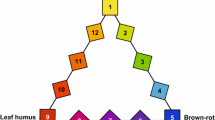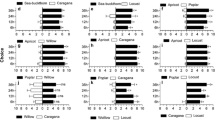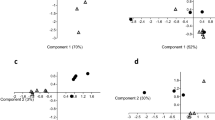Summary
Larvae of the aspen blotch miner, Phyllonorycter salicifoliella Chambers (Lepidoptera: Gracillariidae), feed within leaves of three host-tree species in north-central Minnesota, USA. Far more individuals occur on Populus tremuloides than on P. balsamifera or P. grandidentata. We tested whether this pattern of host use reflected variable performance among alternative hosts by examining survivorship, sources of mortality, pupal mass, feeding efficiency, and development time of miners on each tree species. We also determined foliar water, nitrogen, condensed tannin, and phenolic glycoside content of host trees to test if host-tree chemical attributes were responsible for differences in performance. There was no significant difference in egg-to-adult survival among miners on different hosts, although dominant sources of mortality did vary. Miners on P. grandidentata suffered less parasitism and more predation than those on the other hosts, even though most parasitoid species attacked miners on all hosts. The other performance parameters varied among host species, but not in a consistent pattern. Pupal mass was greatest on P. tremuloides and P. balsamifera, the hosts with comparatively high foliar nitrogen and low phenolic glycoside concentrations. However, feeding efficiency was greatest and development time shortest for miners on P. grandidentata. Thus, pupal mass was the only index of performance maximized on P. tremuloides, the most commonly used host. Infrequent occurrence of Phyllonorycter salicifoliella on P. grandidentata results in part from phenological differences between this and the other host species. Low oviposition rates on P. balsamifera are correlated with low abundance of this host at the study site and a phenolic glycoside profile different from that of the other host species.
Similar content being viewed by others
References
Alberts JD (1989) Success of the aspen blotch miner, Phyllonorycter salicifoliella, on three host-tree species. M.S. thesis, University of North Dakota
Auerbach M (1990) Population dynamics of a leaf-mining insect at endemic and epidemic densities. Symp Biol Hung 39:435–436
Auerbach M (1991) Relative impact of interactions within and between trophic levels during an insect outbreak. Ecology (in press)
Auerbach M, Simberloff D (1988) Rapid leaf-miner colonization of introduced trees and shifts in sources of herbivore mortality. Oikos 52:41–50
Auerbach M, Strong D (1981) Nutritional ecology of Heliconia herbivores: experiments with plant fertilization and alternative hosts. Ecol Monogr 51:63–83
Barbosa P, Greenblatt J (1979) Suitability, digestibility, and assimilation of various host plants of the gypsy moth, Lymantria dispar L. Oecologia 43:111–119
Bernays E, Graham M (1988) On the evolution of host specificity in phytophagous arthropods. Ecology 69:886–892
Broadhurst RB, Jones WT (1978) Analysis of condensed tannins using acidified vanillin. J Sci Food Agric 29:788–794
Clancy KM, Price PW (1987) Rapid herbivore growth enhances enemy attack: sublethal plant defenses remain a paradox. Ecology 68:733–737
Denno RF, Larsson S, Olmstead KL (1990) Role of enemy-free space and plant quality in host-plant selection by willow beetles. Ecology 71:124–137
Faeth SH (1985) Host leaf selection by leaf miners: interactions among three trophic levels. Ecology 66:870–875
Faeth SH (1986) Indirect interactions between temporally separated herbivores mediated by the host plant. Ecology 67:479–494
Fox LR, Morrow PA (1981) Specialization: species property or local phenomenon. Science 211:887–893
Hagstrum DW, Milliken GA (1981) Quantitative analysis of temperature, moisture, and diet factors affecting insect development. Ann Entomol Soc Am 81:539–546
Haukioja E, Neuvonen S (1985) The relationship between size and reproductive potential in male and female Epirrita autumnata (Lep., Geometridae). Ecol Entomol 10:267–272
Holden CE, Ehrlich PR (1982) Ecological determinants of food plant choice in the checkerspot butterfly Euphydryas editha in Colorado. Oecologia 52:417–423
Hough JA, Pimentel D (1978) Influence of host foliage on development, survival and fecundity of the gypsy moth. Environ Entomol 7:97–102
Jervis MA, Kidd NAC (1986) Host-feeding strategies of hymenopteran parasitoids. Biol Rev 61:395–434
Lawton JH (1978) Host-plant influences on insect diversity: the effects of space and time. Symp Royal Entomol Soc 9:105–125
Lindroth RL, Petersen SS (1988) Effect of plant phenols on performance of southern armyworm larvae. Oecologia 75:185–189
Lindroth RL, Scriber JM, Hsia MTS (1986) Differential responses of tiger swallowtail subspecies to secondary metabolites from tulip tree and quaking aspen. Oecologia 70:13–19
Lindroth RL, Hsia MTS, Scriber JM (1987) Seasonal patterns in the phytochemistry of three Populus species. Biochem Syst Ecol 15:681–686
Lindroth RL, Scriber JM, Hsia MTS (1988) Chemical ecology of the tiger swallowtail: mediation of host use by phenolic glycosides. Ecology 69:814–822
Marks ML (1976) Mating behavior and fecundity of the red bollworm Diparapis catanea Hmps. (Lepidoptera: Noctuidae) Bull Entomol Res 66:145–158
Martin JL (1956) The bionomics of the aspen blotch miner, Lithocolletis salicifoliella Cham. (Lepidoptera: Gracillariidae). Can Entomol 88:155–168
Mattson WJ (1980) Herbivory in relation to plant nitrogen content. Annu Rev Ecol Syst 11:119–161
Mopper S, Faeth SH, Boecklen WJ, Simberloff DS (1984) Host-plant specific variation in leaf miner population dynamics: effects on densities, natural enemies, and behavior of Stilbosis quadricustatella (Cham.) (Lepidoptera: Cosmopteridae). Ecol Entomol 9:169–177
Powell JA (1980) Evolution of larval food preferences in microlepidoptera. Annu Rev Entomol 25:133–159
Price PW (1983) Hypotheses on organization and evolution in phytophagous insect communities. In: Denno RF, McClure MS (eds) Variable plants and herbivores in natural and managed systems. Academic Press, New York, pp 559–598
Price PW, Bouton CE, Gross P, McPheron BA, Thompson JN, Weis AE (1980) Interactions among three trophic levels: influence of plants on interactions between insect herbivores and natural enemies. Annu Rev Ecol Syst 11:41–65
Rausher MD (1980) Host abundance, juvenile survival, and oviposition preference in Battus philenor. Evolution 34:342–355
Rausher MD (1984) Tradeoffs in performance on different hosts: evidence from within and between-site variation in the beetle Deloyala guttata. Evolution 38:582–595
Rodman JE, Chew FS (1980) Phytochemical correlates of herbivory in a community of native and naturalized Cruciferae. Biochem Syst Ecol 8:43–50
Roininen H, Tahvanainen J (1989) Host selection and larval performance of two willow feeding sawflies. Ecology 70:129–136
Scriber JM, Feeny P (1979) Growth of herbivorous caterpillars in relation to feeding specialization and to growth form of their food plants. Ecology 60:829–850
Scriber JM, Slansky F (1981) The nutritional ecology of immature insects. Annu Rev Entomol 26:183–211
Singer MC (1983) Determinants of multiple host use by a phytophagous insect population. Evolution 37:389–403
Singer MC (1988) The definition and measurement of oviposition preference in plant-feeding insects. In: Miller J, Miller TA (eds) Insect-plant relations. Springer-Verlag, New York, pp 66–94
Slansky F, Feeny P (1977) Stabilization of the rate of nitrogen accumulation by larvae of the cabbage butterfly on wild and cultivated food plants. Ecol Monogr 47:209–228
Smiley J (1978) Plant chemistry and the evolution of host specificity: new evidence from Heliconius and Passiflora. Science 201:745–747
Stanton ML (1983) Spatial patterns in the plant community and their effects upon insect search. In: Ahmad S (ed) Herbivorous insects: host-seeking behavior and mechanisms. Academic Press, New York, pp 125–157
Still CW, Kahn M, Mitra A (1978) Rapid chromatographic technique for preparative separations with moderate resolution. J Org Chem 43:2923–2925
Thompson JN (1988) Evolutionary ecology of the relationship between oviposition preference and performance of offspring in phytophagous insects. Entomol Exp Appl 47:3–14
Thompson JN, Pellmyr O (1991) Evolution of oviposition behavior and host preference in lepidoptera. Annu Rev Entomol 36:65–89
Via S (1984) The quantitative genetics of polyphagy in an insect herbivore. II. Correlations in larval performance within and among host plants. Evolution 38:896–905
Author information
Authors and Affiliations
Rights and permissions
About this article
Cite this article
Auerbach, M., Alberts, J.D. Occurrence and performance of the aspen blotch miner, Phyllonorycter salicifoliella, on three host-tree species. Oecologia 89, 1–9 (1992). https://doi.org/10.1007/BF00319008
Received:
Accepted:
Issue Date:
DOI: https://doi.org/10.1007/BF00319008




